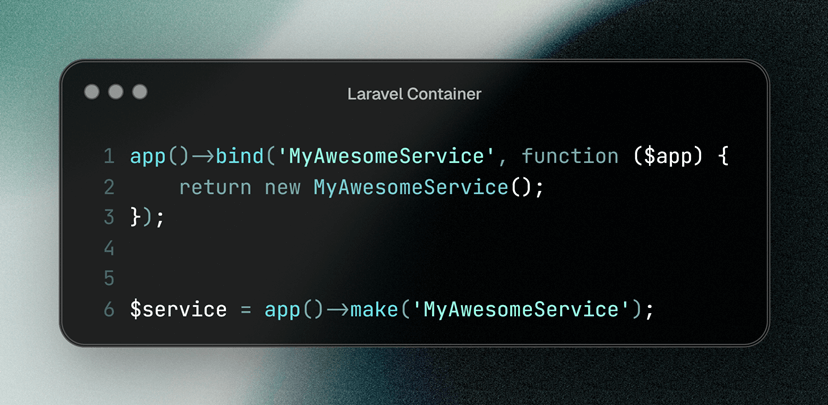Hey there, fellow code wranglers! 👋 Today, we’re diving headfirst into the magical world of the Laravel Container. If you’ve ever wondered how Laravel manages to make dependency injection feel like a walk in the park, you’re in for a treat. Buckle up, because we’re about to unravel the mysteries of the container, and trust me, it’s going to be a wild ride! 🎢
What the Heck is a Container Anyway? 🤔
Alright, let’s start with the basics. The Laravel Container, also known as the Service Container, is like the ultimate backstage manager for your application. It’s responsible for managing class dependencies and performing dependency injection. In simpler terms, it’s the magic wand that helps Laravel resolve and inject dependencies automatically. 🪄
Think of it as a giant box of Lego pieces. You tell the container what pieces you need, and it hands them over to you, all pre-assembled and ready to go. No more manual labor, no more headaches. Just pure, unadulterated coding bliss. 😎
Binding and Resolving: The Dynamic Duo 🦸♂️🦸♀️
The container works in two main ways: binding and resolving. Let’s break it down.
1. Binding: “Hey Container, Remember This!”
Binding is like telling the container, “Hey, when I ask for this thing, give me that thing.” You can bind a class, an interface, or even a simple string to a concrete implementation.
Here’s how you do it:
app()->bind('MyAwesomeService', function ($app) {
return new MyAwesomeService();
});In this example, we’re telling the container that whenever we ask for MyAwesomeService, it should create a new instance of MyAwesomeService for us. Easy peasy, right?
2. Resolving: “Hey Container, Gimme That Thing!”
Resolving is when you ask the container to give you the thing you bound earlier. You can resolve dependencies in multiple ways, but the most common one is using the make() method.
$service = app()->make('MyAwesomeService');Boom! Just like that, the container hands you an instance of MyAwesomeService. No need to manually instantiate it. The container does all the heavy lifting for you. 💪
Singleton Binding: One to Rule Them All 👑
Sometimes, you don’t want a new instance every time you resolve a dependency. Sometimes, you want the same instance to be reused throughout the application. That’s where singleton binding comes into play.
app()->singleton('MyAwesomeService', function ($app) {
return new MyAwesomeService();
});With this, no matter how many times you resolve MyAwesomeService, you’ll always get the same instance. It’s like having a loyal pet that never leaves your side.
Automatic Dependency Injection: The Real Magic ✨
Now, here’s where the container truly shines. Laravel can automatically resolve dependencies for you when you type-hint them in your controllers, jobs, or other classes. Let’s say you have a UserController that needs an instance of UserService. Here’s how you’d do it:
class UserController extends Controller
{
protected $userService;
public function __construct(UserService $userService)
{
$this->userService = $userService;
}
public function show($id)
{
$user = $this->userService->find($id);
return view('user.profile', compact('user'));
}
}Notice how we didn’t manually instantiate UserService? That’s because the container automatically resolves it for us. It’s like having a personal assistant who knows exactly what you need before you even ask. 🕴️
Contextual Binding: When One Size Doesn’t Fit All 🎭
Sometimes, you might want to bind a dependency differently based on where it’s being used. That’s where contextual binding comes in. Let’s say you have a NotificationService that behaves differently in a UserController and a AdminController. Here’s how you can handle that:
app()->when(UserController::class)
->needs(NotificationService::class)
->give(function () {
return new EmailNotificationService();
});
app()->when(AdminController::class)
->needs(NotificationService::class)
->give(function () {
return new SmsNotificationService();
});With this, the container knows to provide EmailNotificationService when UserController asks for NotificationService, and SmsNotificationService when AdminController asks for it. It’s like having a chameleon that adapts to its surroundings. 🦎
Extending Bindings: Because You Can’t Always Get What You Want 🛠️
Sometimes, you might want to modify a binding after it’s been defined. That’s where extending comes in. You can extend a binding to add additional functionality or modify its behavior.
app()->extend('MyAwesomeService', function ($service, $app) {
return new DecoratedService($service);
});In this example, we’re wrapping MyAwesomeService with DecoratedService. It’s like adding a fancy new case to your phone. Same phone, but with a little extra pizzazz. 📱✨
Conclusion: The Container is Your Best Friend 🤗
And there you have it, folks! The Laravel Container is like the Swiss Army knife of dependency management. It’s powerful, flexible, and downright magical. Whether you’re binding, resolving, or extending, the container has got your back.
So next time you’re knee-deep in dependencies, just remember: the container is your best friend. Treat it well, and it’ll treat you even better. Happy coding! 🎉
Got any cool container tricks up your sleeve? Share them in the comments below! Let’s keep the conversation going. 🚀


Leave a Reply